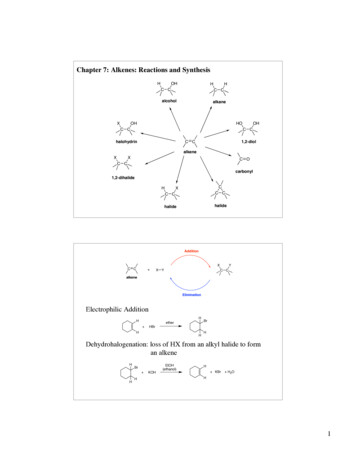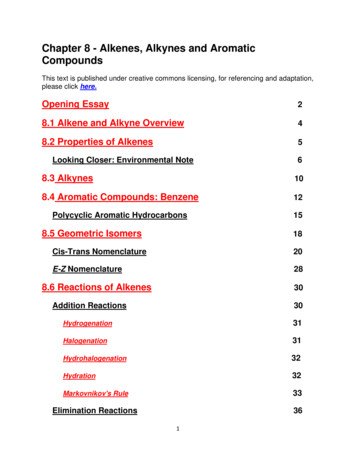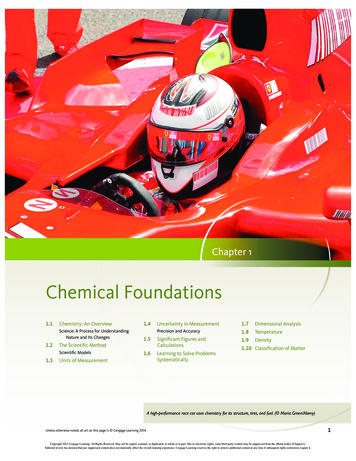
Transcription
Chapter 7: Alkenes: Reactions and SynthesisHXOHHHC CC CalcoholalkaneOHHOC COHC CC Chalohydrin1,2-diolalkeneXXC OC Ccarbonyl1,2-dihalideC CCC ChalidehalideHXAdditionXC C X YYC CalkeneEliminationElectrophilic AdditionHHether BrHBrHHHDehydrohalogenation: loss of HX from an alkyl halide to forman alkeneHBr HHKOHEtOH(ethanol)H KBr H2OH1
Hydration: addition of water (H-OH) across a double bond togive an alcoholHHH OHH2OHHHDehydration: Loss of water (H-OH) from an alcohol to give analkeneHOHHH H2OHHHAddition of Halogens (X2) to Alkenes: 1,2-dihalidesX2XXC CC Calkene1,2-dihalideBrBr Br2BrBrnot observed1,2-dibromide has the anti stereochemistryBromonium ion intermediate controls the stereochemistry2
Halohydrin Formation"X-OH"XOHC CC CalkenehalohydrinBr2, H2OX HBrOHantistereochemistryOrganic molecules are sparingly soluble in water as solvent. The reaction is oftendone in a mix of organic solvent and water using N-bromosuccinimide (NBS) asthe electrophilic bromine source.O OOHN BrBrDMSO, H2O N HOONote that the aryl ring does not react!!!For unsymmterical alkenes, halohydrin formation isMarkovnikov-like in that the orientation of the addition ofX-OH can be predicted by considering carbocation stabilityd CH3more d charge on themore substituted carbonBr d d H2O adds in the second step and adds to thecarbon that has the most d charge and endsup on the more substituted end of the double bondCH3Br2, H2OHOHCH3BrBr adds to the double bond first (formation ofbromonium ion) and is on the least substitutedend of the double bond3
Hydration of Alkenes: addition of water (H-OH) across the p-bondof an alkene to give an alcohol.1. Acid catalyzed hydration- Markovnikov addition of H-OHNot a good method for hydration of an alkene2. Oxymercuration- Markovnikov addition H-OHHO1) Hg(OAc)2, H2O2) NaBH4CH3HCH3H3. Hydroboration- Anti-Markovnikov addition of H-OH,Syn addition of H-OH1) B2H6, THF2) H2O2, NaOH, H2OCH3HHOHHBHHBHB2H6 (diborane)HOtetrahydrofuran(THF)2CH3HH3B O borane-THFcomplex4
Reaction of Alkenes with Carbenes to give CyclopropanesCarbene: highly reactive, 6-electron species.(sp2-hybridized)Generation and Reaction of Carbenes:CHCl3 KOHCl2C: H2O KCldichlorocarbeneCHCl3, KOHHClClHSimmons-Smith Reaction (cyclopropanation)etherCH2I2 Zn(Cu)I-CH2-Zn-I “H2C:”methylenecarbeneCH2I2, Zn(Cu)HetherH5
The cyclopropanation reaction of an alkene with a carbene takes placein a single step. There is NO intermediate.As such, the geometry of the alkene is preserved in the product.Groups that are trans on the alkene will end up trans on thecyclopropane product. Groups that are cis on the alkene will endup cis on the cyclopropane product.HHRRCH2I2, , genation: Addition of H2 across the p-bond of an alkene togive an alkane. This is a reduction.H2, PtO2ethanol The reaction uses H2 and a precious metal catalyst. The catalysts is not soluble in the reaction media, thus this processis referred to as a heterogenous catalysis. The catalyst assists in breaking the p-bond of the alkene andthe H-H s-bond. The reaction takes places on the surface of the catalyst. Thus, the rateof the reaction is proportional to the surface area of the catalyst. To increase the surface area of the catalyst it is finely dispersed onan inert support such as charcoal (carbon, C) Carbon-carbon p-bond of alkenes and alkynes can be reduced to thecorresponding saturated C-C bond. Other p-bond bond such asC O (carbonyl) and C N are not easily reduced by catalytichydrogenation. The C C bonds of aryl rings are not easily reduced.6
Catalysts: Pt2O (Adam’s catalyst) or Pd/Cmechanism:The addition of H2 across the p-bond is synOOH2, PtO2ethanolOOHC5H11H2, Pd/CCH3(CH2)16CO2HLinoleic Acid (unsaturated fatty acid)Steric Acid (saturated fatty acid)OOOCH3H2, Pd/COCH3ethanolCH2, Pd/CNCH3CH3CethanolHH2, PtO2ethanolHNCH3CH3HCH3Hsyn additionof H2CH3Not observed7
Oxidation of Alkenes to 1,2-Diols and CarbonylHydroxylation: formal addition of HO-OH across the p-bond of analkene to give a 1,2-diol. This is an overall oxidation.H1) OsO42) NaHSO3HHO OOsO OHOHsyn additionOHosmate ester intermediate- not usually isolate- NaHSO3 breaks down theosmate ester to the productOzonolysis: oxidative cleavage of an alkene to carbonyl compounds.The p- and s-bonds of the alkene are broken and replaced withC O doubled bonds.C C of aryl rings, C N and C O do not react with ozone,C C react very slowly with ozone3 O2Ozone (O3):R1R2R3R4O3, CH2Cl2-78 COR1R2OOR3R4molozonideelectricaldischargeR1R22 O3O OOozonideR3R4OZn OOR1R3O R2OR4 ZnO8
1) O32) ZnO 1) O32) ZnOHO1) O32) Zn O CH2OHOOxidative Cleavage of 1,2-Diols to Carbonyl CompoundsHOR1R2OHR3R4NaIO4R1THF, H2OR2R3O OR4 ZnOOHOIOOOR1R2OHOHperiodate intermediateR3R4ONaIO4HHO9
O Os O O O osmate ester intermediate - not usually isolate - NaHSO3breaks down the osmate ester to the product Ozonolysis: oxidative cleavage of an alkene to carbonyl compounds. The p- and s-bonds of the alkene are broken and replaced with C O doubled bonds. C C of aryl rings, C N and C O do not react wi










